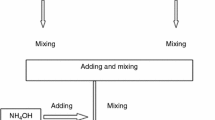Abstract
Iron is a vital element of cellular function within the body. High concentrations of iron can be found in the kidneys and the circulatory system. In bones and teeth it is present as a trace element. The use of iron-based compounds in combination with hydroxyapatite offers a new alternative for prosthetic devices. This work investigates the synthesis and processing of iron containing apatites as a possible new type of ceramic for biomedical devices. Stoichiometric and calcium deficient iron containing apatites were synthesized by a wet chemical reaction with di-ammonium-hydrogen-phosphate, calcium nitrate and a ferrous iron nitrate solution. A secondary phase of tri-calcium-phosphate (TCP) was observed after heat treatment of iron containing, calcium deficient, hydroxyapatite. The apatite structure was maintained after heat treatment of stoichiometric apatite, synthesized in the presence of iron. Sintering in air produced oxidation of Fe2+ to Fe3+, resulting in the formation of hematite as a secondary phase. The introduction of iron into the synthesis of hydroxyapatite causes: (i) an increase of the a-lattice parameter after synthesis and heat treatment in air; (ii) an increase in the c-lattice parameter after sintering in air.
Similar content being viewed by others
References
A. EKTESSABI, et al., X-ray Spectrom. 30(1) (2001) 44.
W. SUCHANEK and M. YOSHIMURA, J. Mater. Res. 13(1) (1998) 94.
K. A. GROSS, et al., Europ. Cells and Mater. 3(2) (2002) 114.
J. L. MEYER and B. O. FOWLER, Inorg. Chem. 21 (1982) 3029.
S. E. P. DOWKER and J. C. ELLIOTT, Calcif. Tiss Int. 29 (1979) 177.
Idem., J. Solid State Chem. 49 (1983) 334.
M. VALLET-REGI, L. M. RODRIGUEZ-LORENZO and A. J. SALINAS, Solid State Ionics 101 (1997) 1279.
J. C. ELLIOTT, “Structure and Chemistry of the Apatites and Other Calcium Orthophosphates” (Studies in Organic Chemistry, Elsevier, Amsterdam 1994) vol. 18, p. 389.
B. O. FOWLER, Inorg. Chem. 13(1) (1974) 194.
B. O. FOWLER, E. C. MORENO and W. E. BROWN, Arch. Oral. Biol. 11 (1966) 477.
B. SUTTER, et al., Soil. Sci. Soc. Amer. J. 67(6) (2003) 1935.
J. ZHOU, et al., J. Mater. Sci.: Mater. Med. 4 (1993) 83.
S. PUAJINDANERT, S. BEST and W. BONDFIELD, British. Ceram. Trans. 3 (1993) 96.
L. M. RODRIGUEZ-LORENZO, M. VALLET-REGI and J. M. F. FERREIRA, Fabrication of Hydroxyapatite Bodies by Uniaxial Pressing from a Precipitated Powder. Biomaterials, 2002.
M. JIANG, et al., Phys. Rev. B 6622(22) (2002) 4107.
Author information
Authors and Affiliations
Corresponding author
Rights and permissions
About this article
Cite this article
Morrissey, R., Rodríguez-Lorenzo, L.M. & Gross, K.A. Influence of ferrous iron incorporation on the structure of hydroxyapatite. J Mater Sci: Mater Med 16, 387–392 (2005). https://doi.org/10.1007/s10856-005-6976-5
Received:
Accepted:
Issue Date:
DOI: https://doi.org/10.1007/s10856-005-6976-5




